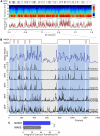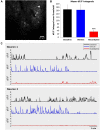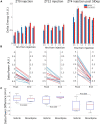Dihydropyridine calcium blockers do not interfere with non-rapid eye movement sleep
- PMID: 36340773
- PMCID: PMC9626806
- DOI: 10.3389/fnins.2022.969712
Dihydropyridine calcium blockers do not interfere with non-rapid eye movement sleep
Abstract
Non-rapid eye movement (NREM) sleep is tightly homeostatically regulated and essential for survival. In the electroencephalogram (EEG), oscillations in the delta (0.5-4 Hz) range are prominent during NREM sleep. These delta oscillations are, to date, the best indicator for homeostatic sleep regulation; they are increased after prolonged waking and fade during NREM sleep. The precise mechanisms underlying sleep homeostasis and the generation of EEG delta oscillations are still being investigated. Activity-dependent neuronal calcium influx has been hypothesized to play an important role in generating delta oscillations and might be involved in downstream signaling that mediates sleep function. Dihydropyridine blockers of L-type voltage-gated calcium channels (VGCCs) are in wide clinical use to treat hypertension and other cardiovascular disorders and are readily blood-brain-barrier penetrant. We therefore, wanted to investigate their potential effects on EEG delta oscillation and homeostatic NREM sleep regulation in freely behaving mice. In vivo two-photon imaging of cortical neurons showed larger spontaneous calcium transients in NREM sleep compared to waking. Application of the dihydropyridine calcium blocker nicardipine significantly reduced cortical calcium transients without affecting the generation of delta oscillations. Nicardipine also did not affect EEG delta oscillations over 24 h following application. The time spent in NREM sleep and NREM episode duration was also not affected. Thus, acute block of calcium entry through L-type VGCCs does not interfere with EEG delta oscillations or their homeostatic regulation, despite prior evidence from calcium channel knockout mice.
Keywords: NREM; calcium imaging; delta activity; dihydropyridine; non-rapid eye movement wave sleep; voltage gated calcium channel.
Copyright © 2022 Han, Matsumoto, Diaz, Greene and Vogt.
Conflict of interest statement
The authors declare that the research was conducted in the absence of any commercial or financial relationships that could be construed as a potential conflict of interest.
Figures



Similar articles
-
A role for cortical nNOS/NK1 neurons in coupling homeostatic sleep drive to EEG slow wave activity.Proc Natl Acad Sci U S A. 2013 Dec 10;110(50):20272-7. doi: 10.1073/pnas.1314762110. Epub 2013 Nov 4. Proc Natl Acad Sci U S A. 2013. PMID: 24191004 Free PMC article.
-
Behavioral sleep-wake homeostasis and EEG delta power are decoupled by chronic sleep restriction in the rat.Sleep. 2015 May 1;38(5):685-97. doi: 10.5665/sleep.4656. Sleep. 2015. PMID: 25669184 Free PMC article.
-
NREM delta stimulation following MK-801 is a response of sleep systems.J Neurophysiol. 1996 Dec;76(6):3714-20. doi: 10.1152/jn.1996.76.6.3714. J Neurophysiol. 1996. PMID: 8985869
-
The visual scoring of sleep and arousal in infants and children.J Clin Sleep Med. 2007 Mar 15;3(2):201-40. J Clin Sleep Med. 2007. PMID: 17557427 Review.
-
Ca2+-dependent hyperpolarization hypothesis for mammalian sleep.Neurosci Res. 2017 May;118:48-55. doi: 10.1016/j.neures.2017.03.012. Epub 2017 Apr 20. Neurosci Res. 2017. PMID: 28433628 Review.
References
-
- Aeschbach D., Borbely A. A. (1993). All-night dynamics of the human sleep EEG. J. Sleep Res. 2 70–81. - PubMed
LinkOut - more resources
Full Text Sources

